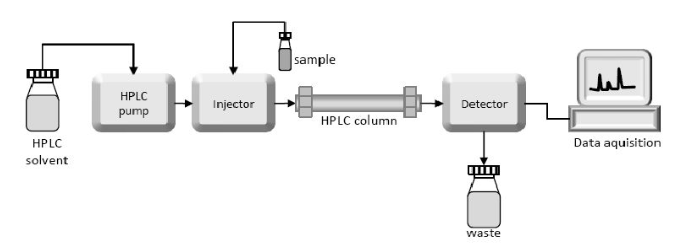The acronym HPLC stands for High Performance Liquid Chromatography. “Chromatography” is a separation technique, “chromatogram” is the chromatography result, and “chromatograph” is the chromatography apparatus. HPLC is a technique for disjointing, determinating, and quantifying each component in a mixture.
Spectroscopy is used to identify and quantify the mixture, which is separated using the fundamental concept of column chromatography. Some of the major components of chromatographs include devices specialised in molecule separation known columns and high-performance pumps for supplying solvent at a steady flow rate, among the different technologies created for chromatography. The system once known as High Performance Liquid Chromatography became known simply as “LC” as associated technologies got more advanced. Ultra High Performance Liquid Chromatography (UHPLC), which is capable of high-speed analysis, is becoming increasingly popular and is being widely used nowadays.
HPLC can only evaluate chemicals that are dissolved in solvents. HPLC separates chemicals dispersed in a liquid sample, allowing for qualitative and quantitative examination of which components are present in the sample and how much of each component is present.
In the 1960s, LC with low-pressure glass columns evolved into high-pressure chromatography (HPLC) using metal columns. As a result, it is a better version of TLC. Instead of allowing a solvent to drop through a column under gravity, it is pushed through at up to 400 atmospheres of pressure.
Principle of HPLC
- A separation column separates the stationary and mobile phases during purification.
- In a separation column, the stationary phase is a granular substance with very small porous particles.
- The mobile phase is a solvent or solvent combination that is pushed through the separation column under high pressure.
- The sample is loaded into the mobile flow regime from the pump to the separation column using a syringe through a valve with a linked sample loop, i.e. a tiny tube or capillary made of stainless steel.
- A chromatogram is generated in the HPLC software at the conclusion of this operation/run.
- The chromatogram allows the various compounds to be identified and quantified.
- As a result, owing to interactions with the stationary phase, the constituent components of a mixture migrate through the column at different speeds.
- Individual compounds are identified by an appropriate detector after exiting the column and transmitted as a signal to the computer’s HPLC software.
Types of HPLC
Normal Phase
This method separates analyses based on their extreme nature. A liquid stationary stage and a non-polar portable stage are used in NP-HPLC. As a result, polar specimens are kept on the polar surface of the column pressing for longer than less polar ones.
Reverse Phase
The stationary stage is hydrophobic, whereas the versatile stage is a polar liquid, such as water-methanol or acetonitrile mixes. It is based on the hydrophobic collaboration rule, which states that the more nonpolar the substance, the more it will be retained.
Size Exclusion
Molecules migrate into pores in a porous media and are segregated based on their size in comparison to the pore size. Large molecules elute first, followed by smaller ones.
Ion Exchange
The mobile phase is buffer, and the column packing comprises ionic groups. It is used to distinguish between anions and cations.
Parts of HPLC

Solvent Reservoir
A glass reservoir holds the mobile stage ingredient. In HPLC, the flexible stage, or dissolvable, is often a mixture of polar and non-polar liquid segments where specific fixations change depending on the specimen arrangement.
Pump
The pump system was developed as a result of the development of HPLC. The pump is located in the upper stream of the liquid chromatographic column and pumps eluent into the system from the solvent reservoir.
Injector
Next to the pump, there is an injector. The easiest way is to use a syringe to insert the sample into the eluent flow. Sampling loops are the most extensively utilised injection mechanism.
Column
The separation takes place within the column. Instead of glass columns, contemporary columns are frequently manufactured in a stainless steel housing. In comparison to calcium carbonate, silica or polymer gels are commonly utilised as packing materials.
Detector
The separation of analytes takes place inside the column, and the separation is seen using a detector. When no analyte is present, the eluent has a constant composition. While the presence of analyte alters the eluent’s composition. These differences are measured by the detector. This disparity is measured using an electrical signal. Different kinds of detectors are available.
Data Collection
Signals from the indicator might be collected via outline recorders or electronic integrators with varying degrees of multi-sided fidelity and the ability to analyse, store, and reprocess chromatographic data. The PC coordinates the identifier’s reaction with each component and records it in a chromatograph that is simple to read and understand.
Uses of HPLC
- Purification of water.
- Impurity detection in the pharmaceutical industry.
- Trace components are pre-concentrated.
- Chromatography based on ligand exchange.
- Protein chromatography via ion exchange.
- Carbohydrate and oligosaccharide anion-exchange chromatography at high pH.
Applications of HPLC
- Drug evaluation
- Synthetic polymer analysis
- Pollution analysis in environmental analytics
- Drug determination in biological matrices
- Isolation of high-value goods
Conclusion
HPLC (high performance liquid chromatography) is a type of column liquid chromatography that has been greatly improved. Instead of allowing a dissolvable to flow through a column under gravity, it is forced to do so under heavyweights of up to 400 climates. As a result, it is substantially faster.
Also check:
 Profile
Profile Settings
Settings Refer your friends
Refer your friends Sign out
Sign out






